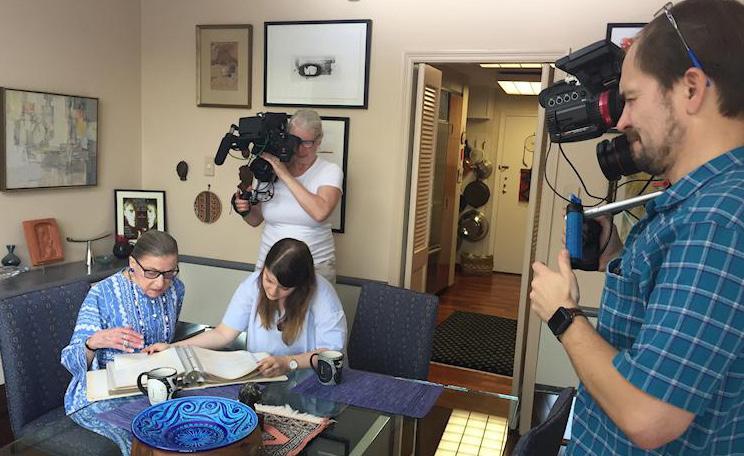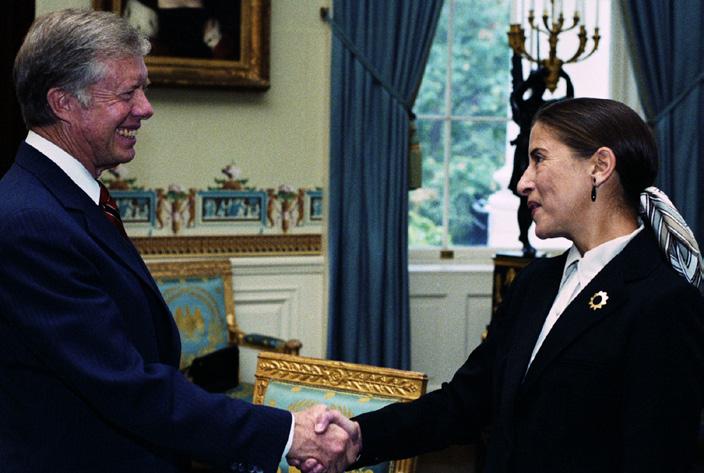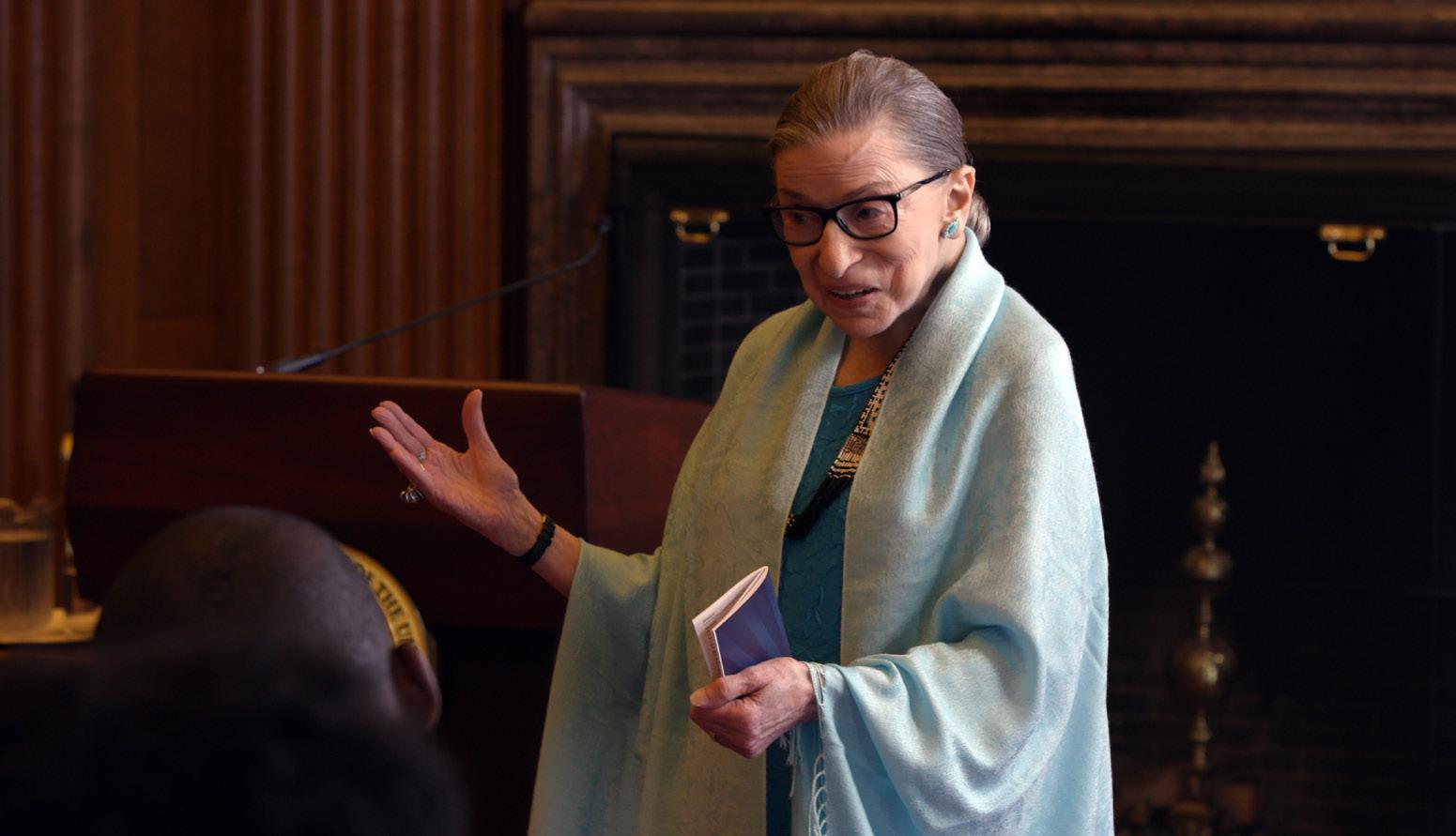
4 minute read
DP Claudia Raschke Talks Shooting The RBG Dcoumentary
DP CLAUDIA RASCHKE TALKS SHOOTINGTHE RBG DOCUMENTARY
At the age of 85, U.S. Supreme Court Justice Ruth Bader Ginsburg has developed a lengthy legal legacy while becoming an unexpected pop culture icon. But the unique personal journey of her rise to the nation’s highest court has been largely unknown, even to some of her biggest fans – until now. "RBG" explores Ginsburg’s life and career. DP Claudia Raschke answers a few questions about working on the film.
Advertisement
PRODUCTIONHUB (PH): How’d you get involved with the RBG documentary?

DP Claudia Raschke shooting the film RBG
CLAUDIA RASCHKE (CR): When I started out as a DP in the biz in 1988 everyone advised me to buy my own camera gear or I would not get hired as a female DP. I refused to buy into it and stood my ground insisting to only be hired for my artistry and not because I had a camera package. A female DP in the feature film industry was a rare sight and often considered too weak to carry the camera, or without the stamina to last a long day, and too emotional to handle the pressure on set, or too soft-spoken to call the shots. I was fighting the lack of confidence in women throughout history, but I kept following my passion.
I have now worked in the film industry for 30 years, shooting feature films with complex lighting setups and feature documentaries with extensive cinema vérité challenges. It has been a great joy to witness that more women are pushing the doors open to produce and direct films. These women are tough, super focused and know what they want.
The "RBG" directing and producing team, Julie Cohen and Betsy West, were already convinced about my expertise in cinematography but also wanted to create an opportunity to have an all-women team to represent the strength of leadership to echo RBG’s equal rights fight throughout her life. The minute they offered me the job, I was on board knowing that we would make an excellent team.

Justice Ginsburg and Jimmy Carter, c.1980. Photo, in RBG, courtesy of Magnolia Pictures/ CNN Films.
PH: What was your favorite part of the project?
CR: Shooting documentaries is most inspirational to me because no two stories are alike. Each experience gives rare access to someone’s inner sanctuary. Each experience as a documentarian causes a shift in the paradigm and each new day of shooting a documentary is an unexpected treasure that will ultimately open one’s mind to new possibilities. For me, that is pure gold. It’s my true inspiration that I hold on to.
Mostly my mind is drawn to look at lighting, contrast ratios and framing for each situation I encounter, no matter if I’m waiting somewhere, sitting in a subway or walking down a street, I’ll catch a glimpse of perfect alignment and hold on as long as the story allows for it. You can’t plan for it, but you have to be alert, to see these opportunities. Therefore, I like to spend as much time as possible on location scouts, imagining the possibilities, talking it through with my directors.
PH: Can you talk about some of the shooting techniques you used?
CR: Every interview had to capture the character’s nature and visually connect them with the location they were in. I chose the camera angles for each location with great care, imagining broad strokes of naturally looking soft light in conjunctions with bright dashes and highlights to let the eye settle in on each interview subject recounting an anecdote about RBG. Shooting with two cameras meant to light for two angles and carefully craft the images to work together in harmony. Therefore, all interview setups have a slight movement to them. Having the camera angle breathe with motion bridged intercuts and represented the flow and wandering of their thoughts.
Cinéma Vérité scenes with RBG had to be as unobtrusive as possible to ensure authenticity. It was our goal to show her nature and magnificence. For this, I worked with mostly natural lights in vérité situations and a set of Canon’s zoom lenses. As a Vérité shooter, one needs to quickly evaluate a location’s sweet spots and downfalls for lighting and grasp the scope of the situation to capture the most cinematic storytelling coverage.
As a former dancer, I rely on my internal sense of choreography to film a scene. Each character has a unique movement which correlates to what role they play at a given moment. With "RBG" I had to learn to move around without disrupting her focus or limit her thinking space. Timing was everything.
PH: How did you have to work with lighting for this doc?
CR: First of all, location scouts are essential, either in person or via photos. They can make or break your cinematic ideas. Keep in mind that documentaries for often can’t spend any money on renting lights. Therefore, I spend time on pre-scouts. I need to know compass orientation for windows, power limits, time of day set for the interview, and obstacles like large unmovable items that will limit my lighting space.
Before I set up lighting, I build my camera to view different angles considering shifting influence of natural light from windows and any other wild cards that could make the window source a possible problem (cars zipping by throwing flashes of reflective lights from the sun, or bright sun lighted green lawn which reflects too much green color through the window).

RBG speaks with students from the film RBG. Photo courtesy of Magnolia Pictures/ CNN Film
Both cameras get set up once I have pinpointed two promising angles to work with including the relative field of view background canvas to be lighted. Setting up the key light is always done in conjunction with the naturally occurring window or door to another room in the background of my frame. Then I determine my contrast ratio. With the key light in place, I set up wrap around fill, a possible edge light, maybe some negative fill, followed by multiple highlights that connect the space to the character.
Once lights are roughed in, I review quality and intensity of lights, as well as shadow angles and altitude of lights. Finally, check zone levels for both cameras to match, set T-stop and focus, review if highlights let the eye flow through the frame resting on the subject in its carved-out character-driven space. It might sound like I have lots of tools to play with, but my lighting kit consists of a small documentary lighting package. Lighting is totally dependent on the location and its glory. That’s why I pre-scout everything. n
Article first published on ProductionHUB on May 10, 2018.



